6 Submerged aquatic macrophytes
Submerged aquatic macrophytes are defined as plants that are usually rooted in the bottom soil with the vegetative parts predominantly submerged. Many different types of submerged aquatic macrophytes have been identified globally.
6.1 Classification
Most submerged aquatic macrophytes belong to the families Ceratophyllaceae, Haloragaceae, Hydrocharitaceae, Nymphaeaceae and Potamogetonaceae. A list of the most commonly occurring ones is presented in Table 6.1. These macrophytes are found in various types of water bodies, including estuaries, rivers, lakes, ponds, natural depressions, ditches, swamps and floodplains. Like other macrophytes, they compete with phytoplankton for nutrients, decreasing the productivity of the water and causing hindrance to the movement of fish, irrigation and navigation.
6.2 Characteristics
Submerged macrophytes are distributed all over the world except some very deep and cold water lakes in polar countries. For example, submerged macrophytes are found in Asia, mid-eastern Europe, eastern Africa, north and Central America and Australia and thus have a wide range of environmental requirements in their natural habitats. Submerged aquatic macrophytes are more commonly found in shallow stagnant waters. Some comments on environmental effects on the composition of submerged aquatic macrophytes are given in section 6.4.
Table 6.1
Common and scientific names of various submerged aquatic macrophytes used as fish feed
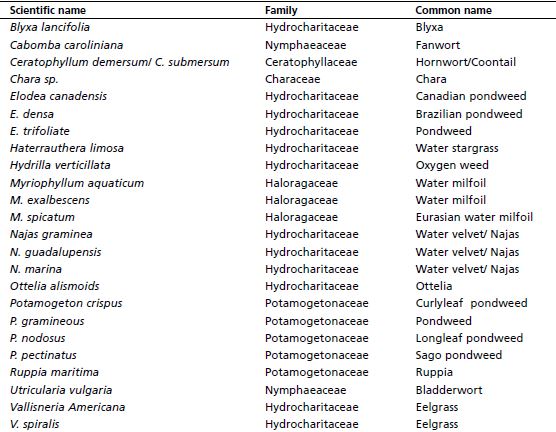
6.3 Production
Production or cultivation techniques have not been developed for most of the submerged macrophytes, probably because this has not been necessary. However, some are used as human food and are therefore cultivated. The tip of the shoots of the Eurasian water milfoil (Myriophyllum spicatum) is eaten as a vegetable in Java (Indonesia) and is cultivated there (Cook et al., 1974). The leaves of Blyxa lancifolia
are eaten as vegetables in India, where it is one of the most popular vegetables and is eaten raw with certain kinds of fish. Another submerged plant, Ottelia alismoides, is also used for human consumption. The entire plant, except the roots, is cooked as a vegetable. Information on the standing crop of submerged macrophytes is scarce, except that Boyd (1968) reported that the standing crop value of submerged plants and algae in lakes in Alabama ranged from 1-4 tonnes/ha. Westlake (1966) reported net production of submerged macrophytes ranging from 4 to 20 tonnes DM organic matter/ha/year in fertile ponds.
6.4 Chemical composition
Chemical analyses of some of the common submerged macrophytes used as fish feed are presented in Table 6.2. Submerged macrophytes generally have a high water content, which is usually a major deterrent to their harvest and utilization (Edwards, 1980). The water content of the submerged macrophytes listed varied from 84 to 96 percent. The water content of hornwort (Ceratophyllum demersum) is particularly high (93-96 percent) and it can thus be described as an ‘absolutely succulent’ type of macrophyte. The crude protein values of these macrophytes varied between 9 and 22 percent DM, although most contained levels of 13-15 percent. Most of the submerged plants contained less than 4 percent lipid, although there were some exceptions, particularly for oxygen weed. The ash content varied widely from 10 to over 56 percent; however, most values were between 15 and 30 percent. Fibre contents varied from 7 to 37 percent but values between 7 and 11 percent were more common.
The apparently wide variations in proximate composition are due to both interspecific and intraspecific differences in macrophytes. For example, Boyd (1968) reported crude protein and ash contents of 10.9 and 16.0 percent respectively for curlyleaf pondweed (Potamogeton crispus), whereas Pine, Anderson and Hung (1990) reported values of 15.2 and 49.2 percent respectively for crude protein and ash for the same macrophyte. Similarly, considerable intraspecific variations in nutritional composition in hornwort, long leaf pondweed (P. nodosus), oxygen weed (Hydrilla verticillata) and water velvet (Najas guadalupensis) were observed by these authors. These variations were more pronounced in the case of ash and fibre contents than protein and lipid. Such intraspecific variations in nutritional composition may also be attributed to variations in geographic locations, seasonality and environment.
Muztar, Slinger and Burton (1978) recorded a large variation in crude protein content (7.5-14.9 percent) in Eurasian water milfoil (M. spicatum), simply due to difference of locations and seasons, although the plant samples were collected from the same lake in Canada. There is evidence that the crude protein content increases as the nutrient content of the water in which the plant is grown increases. Pine, Anderson and Hung (1989) recorded marked variations in proximate composition and acid detergent fibre of three macrophytes species (sago pondweed P. pectinatus, long leaf pondweed P. nodosus and Eurasian water milfoil) grown in canals with either static or flowing water. The greatest differences found were in the levels of dry matter (DM), nitrogen-free extract, ash, and acid detergent fibre. These major variations in proximate composition were possibly correlated with the morphological forms that the plants developed as a response to either static or flowing water conditions. Larger shoots were produced in these three macrophytes when grown in canals with flowing water as opposed to static water (Pine, Anderson and Hung, 1989). Furthermore, Pine,
Table 6.2
Chemical analyses of some common submerged aquatic macrophytes
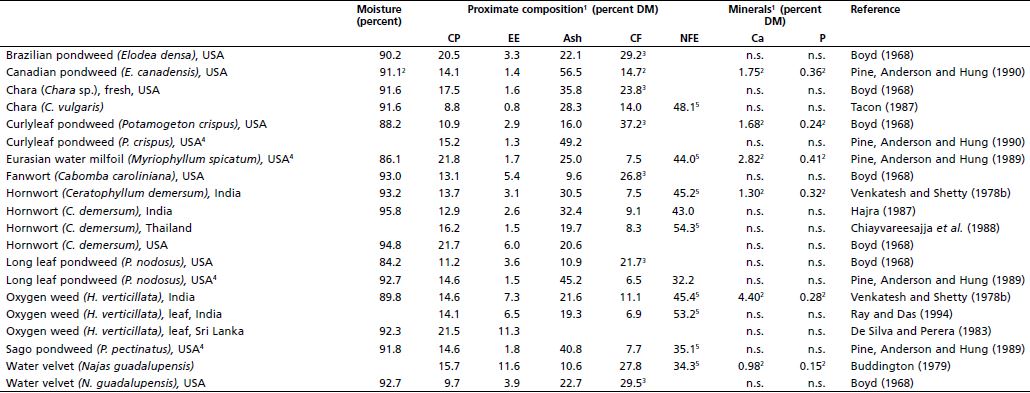
1 CP = crude protein; EE = ether extract; CF = crude fibre; NFE = nitrogen free extract; Ca = calcium; P = phosphorus
2 Data from Tacon (1987)
3 Cellulose
4 Mean of proximate composition values of weeds collected from flowing and static water
5 Adjusted or calculated; not as cited in original publication
Anderson and Hung (1990) observed marked differences in the proximate composition of three aquatic macrophyte species (curlyleaf pondweed P. crispus, Canadian pondweed Elodea canadensis and Eurasian water milfoil) grown in canals having static and flowing water for three seasons (winter, summer and fall). For example, during the winter, the ash content in Eurasian water milfoil was 34.6 percent in static water but 43.5 percent in flowing water. These macrophytes also exhibited significant differences in lipid levels when growing in static or in flowing water, namely 0.5 and 2.0 percent (curlyleaf pondweed), 0.4 and 2.65 (Canadian pondweed), and 0.55 and 1.8 percent (Eurasian milfoil).
For all practical purposes, the crude protein content of Brazilian pondweed and water milfoil may be assumed to be around 20—22 percent, whereas for other submerged macrophytes it may be taken as 13—16 percent (although some exceptions are shown in Table 6.2). Similarly, the
Figure 6.1
Grass carp - a voracious macrophyte feeder
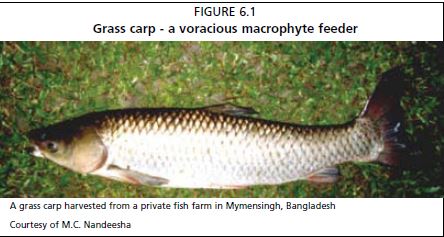
A grass carp harvested from a private fish farm in Mymensingh, Bangladesh Courtesy of M.C. Nandeesha
6.5 Use as aquafeed
crude lipid content of most of the submerged macrophytes is around 4 percent or below, except for fanwort and oxygen weed, which are >5 percent and some individual analyses for hornwort and water velvet (Table 6.2). The extent of intraspecific variation does not permit species-wise generalizations for the ash and fibre contents of submerged macrophytes.
A review of the literature indicates that an extensive number of research studies have been carried out on various submerged macrophytes in different parts of the world. However, most of these studies concern effective control of submerged macrophytes by herbivorous fish. Reports are also available on the species preference and consumption rates of submerged aquatic macrophytes by herbivorous fish. Submerged aquatic macrophytes are generally soft in nature, moderately rich in protein and are preferred by different herbivorous fish. In spite of these attractive qualities, only a limited number of research studies have been carried out on their potential utilization as fish feed in pond aquaculture. The results of these studies are variable and species dependent. The most commonly used as fish feed are chara (Chara sp.) hornwort, oxygen weed (Hydrilla), water velvet (Najas), water milfoil (Myriophyllum) and pondweeds (Elodea). Most studies were on grass carp (Figure 6.1) and tilapia and the submerged macrophytes were fed either in fresh form or as a dried meal within a pelleted diet.
6.5.1 Research studies
A summary of results of selected growth studies carried out on the use of fresh submerged aquatic macrophytes for fish is presented in Table 6.3. Fresh macrophytes are generally given to macrophytophagous fish, either whole or after being cut into small pieces.
In experiments with controlled feeding regimes wherein experimental fish were fed fresh macrophytes as a complete diet in clear water systems (glass aquaria or fibre glass tanks), growth responses were either very poor or negative growth was displayed (Table 6.3). For example, Hajra (1987) reported an SGR of 0.23 percent for grass carp when hornwort was fed ad libitum in a clear water fibreglass rearing system.
Table 6.3
Performance of tilapia, grass carp and shrimp fed fresh submerged aquatic macrophytes
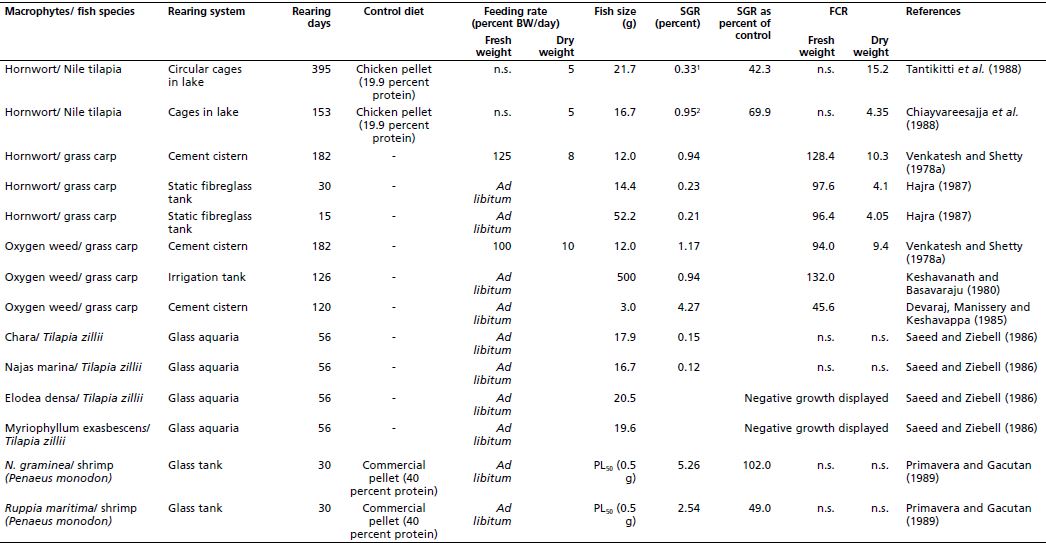
1 SGR of control diet was 0.78 percent, while fish fed no supplementary diet had SGR of 0.55 percent;
2 SGR of control diet was 1.36 percent, while fish fed no supplementary diet had SGR of 1.14 percent
Similarly, poor or negative growth responses were recorded when T. zillii were fed various submerged macrophytes (Chara sp., N. marina, E. dens and M. exalbescens) in a clear water static glass aquarium. Poor performances of Nile tilapia were also recorded by Tantikitti et al. (1988) when fed with fresh hornwort in cage culture. These authors evaluated fresh hornwort as feed for Nile tilapia and compared its growth and profitability with chicken pellets and without supplementary feed. In a 14 month trial in Songkhla lake in Thailand, chicken pellets produced the best growth (weight gain 290 g, SGR 0.78 percent/day), while the performances of fish fed fresh hornwort and those not provided with any supplementary feed were similar (hornwort: weight gain 65.25 g, SGR 0.33 percent/day; no supplementary feed: weight gain 87.7 g, SGR 0.55 percent/day). Fish fed fresh hornwort did not have any advantage over fish cultured without any aquatic weed, either in growth or profitability.
Fish reared in clear water static systems tend to consume much less macrophytes than those reared in cement cisterns and ponds/tanks. Hajra (1987) reported a hornwort consumption rate of 25 percent BW/day for grass carp in glass aquaria while the feeding rate used by Venkatesh and Shetty (1978a) for grass carp for the same macrophyte in cement cisterns was 100 percent BW/day. The variability in growth responses between clear water indoor static systems and outdoor rearing systems/ ponds might be attributed to the differences in their consumption rates. Moreover, submerged aquatic macrophytes usually contain about 13-16 percent protein (Table 6.2). The dietary protein requirement of tilapia and grass carp is much higher (32-40 percent), which the macrophytes could not generally provide. Therefore, fish cultured only on a macrophyte diet either lose weight or grow very slowly. The better growth responses in cement cisterns, earthen ponds or tanks can also be attributed to the presence of other food organisms such as plankton, benthos, etc.
It is difficult to compare the performances of different macrophytes because of the variability of rearing systems, experimental duration and fish species. Nevertheless, grass carp appeared to have performed better when fed oxygen weed than when fed hornwort (Figure 6.2). Venkatesh and Shetty (1978a) obtained an SGR of 0.94 percent BW/day for hornwort, while an SGR of 1.17 was recorded for oxygen weed in the same experimental study. Devaraj, Manissery and Keshavappa (1985) recorded an SGR of 4.27 percent for grass carp by feeding oxygen weed ad libitum in an experimental study conducted for 120 days. CIFA (1981) found hornwort to be a poor inducer of growth, probably due to its poor digestibility.
Attempts have also been made to use dried submerged macrophytes in pelleted feeds for fish. Drying reduces the moisture
Figure 6.2
Farmers carrying mixture of hornwort and oxygen weed in rickshaw van for feeding their fish (Jessore, Bangladesh)
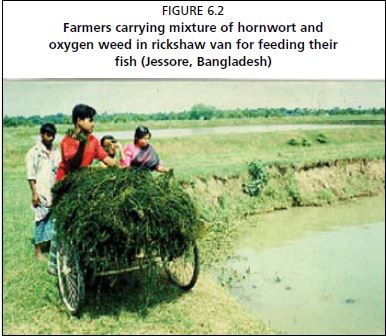
content and increases the stability and form of macrophytes. However, the number of studies is extremely limited. A summary of the results of growth studies carried out on the use of hornwort meal in dry or semi moist pelleted feeds for Nile tilapia is presented in Table 6.4. Test diets were prepared by using varying inclusion levels of hornwort meal ranging from 40-98 percent in combination with rice bran and/ or fishmeal. In these studies the performances of fish fed the test diets were sometimes compared with control diets that consisted of chicken pellets or commercial fish pellets containing 16.8-20.7 percent crude protein. In all cases where control diets were used the performances of fish fed the test diets were significantly lower than the control. In some cases the fish fed the test diets produced growth responses even lower than those given no supplementary feed. For example, Chiayvareesajja et al. (1988) fed test diets containing various inclusion levels of hornwort meal and obtained SGRs varying from 1.01 to 1.21 in cages, while the SGR of the control diet was 1.36 percent and the fish given no supplementary feed had a SGR of 1.14. It should also be pointed out that the control diets themselves may have produced sub-optimal growth, as their protein contents varied between 16.8- 20.7 percent, much lower than the optimum requirements of grass carp found when a complete diet is tested in a clear water system.
6.5.2 On-farm utilization
Reports on the on-farm utilization of submerged macrophytes are rather limited. Bala and Hasan (1999) reported the efficient on farm utilization of submerged macrophytes in oxbow lakes located in southwestern Bangladesh. Oxbow lakes (local name: baors) are semi closed water bodies, cut off from old river channels in the delta of the Ganges. There are approximately 600 oxbow lakes in southwestern Bangladesh, with an estimated combined water area of 5 000 ha. Many of these oxbow lakes have
Figure 6.3
Cultivation of watercress, Nasturtium officinale in a bamboo frame for feeding of fish in cages (Son La Province, Viet Nam)
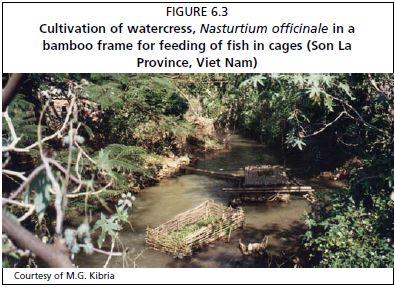
Courtesy of M.G. Kibria
been brought under culture-based fisheries management by screening the inlets and outlets.
Six carp species, i.e. Indian major carps (rohu, catla, mrigal), Chinese carps (silver carp and grass carp) and common carp, are regularly stocked and harvested almost throughout the year. The stocking density and species ratios vary widely between lakes and depend on the water colour and presence of macrophytes in the lake (Hasan and Middendorp, 1998; Bala and Hasan, 1999). Fishers generally stock more silver carp in lakes with green water and more grass carp in lakes with a greater coverage of floating and submerged macrophytes. The most commonly available aquatic macrophytes in oxbow lakes are water hyacinth (Enhydra fluctuans), water spinach (Ipomoea aquatica), duckweed (Lemna minor and L. major), oxygen weed, hornwort, pondweeds (P. crispus and P. nodosus), eelgrass (Vallisneria spiralis), monocharia (Monochoria hastata), lotus (Nelumbo nucifera) and water lily (Nymphaea spp.). The most preferred aquatic macrophytes for grass carp in oxbow lakes are water spinach, duckweed, oxygen weed, hornwort and pondweeds (Potamogeton). Grass carp also eat the tender leaves of eelgrass. Average stocking densities and yields of each fish species, grouped by the predominant water colour (green, brown and clear) of 14 oxbow lakes managed under the Oxbow Lakes Project II are shown in Table 6.5. Green water lakes are oxbow lakes with distinct algal blooms, as indicated by low Secchi readings, and also generally have little or no aquatic vegetation. On the other hand brown water lakes have comparatively more aquatic vegetation. Clear water lakes mostly have a comparatively high cover of floating and submerged aquatic vegetation. Green water lakes produce the highest yield of silver carp while a higher yield of grass carp is recorded in clear water lakes.
On-farm utilization of aquatic macrophytes in cage culture in oxbow lakes in southwestern Bangladesh (Figure 6.4) has also been observed by the first author of this
Table 6.4
Performance of Nile tilapia (Oreochromis niloticus) fed pelleted feeds containing dried hornwort (C. demersum) meal

1 SGR of control diet was 1.36 percent, while fish fed no supplementary diet had SGR of 1.14 percent
document. Selected fresh submerged, floating and emergent aquatic macrophytes are used as feed for fingerling rearing in cages floated in oxbow lakes by farmers, with the help of local NGOs. Grass carp, common carp, Java barb (Barbonymus gonionotus) and Nile tilapia fry (1.5-2.0 inch) are stocked and reared for about two months until they attained about 4-6 inch. Indian major carps (rohu and mrigal) are also occasionally stocked. The stocking rate varies between 1 400 and 1 600 per 8 m3 (2 m x 2 m x 2 m) cage. Two stocking combinations are normally used: grass carp, common carp and tilapia; or grass carp and Java barb. Grass carp generally form the bulk (70-75 percent) of the stock. Chopped or whole fresh macrophytes are put into the cages in the morning, along with 3 kg of a rice bran—wheat bran—oil cake mixture (7:1:2). Ad libitum feeding or a fixed quantity of 4-5 kg of fresh macrophytes is provided to each cage every day. The most
commonly used macrophytes are: submerged – pondweeds, oxygen weed, hornwort and eelgrass; floating – duckweed (Wolffia arrhiza); and emergent - Monochoria hastata. Pondweeds, oxygen weed, hornwort and duckweed are readily eaten by grass carp, tilapia and Java barb, whereas the roots and tender leaves of Monochoria and the tender leaves of eelgrass are generally eaten only by grass carp. Good results are obtained with grass carp and tilapia/Java barb. Jagdish, Rana and Agarwal (1995) and Aravindakshan et al. (1999) recommended the use of
Figure 6.4
Mixtures of selected fresh submerged, floating and emergent aquatic macrophytes are given as feed for fingerling rearing in cages floated in oxbow lakes in southwestern Bangladesh
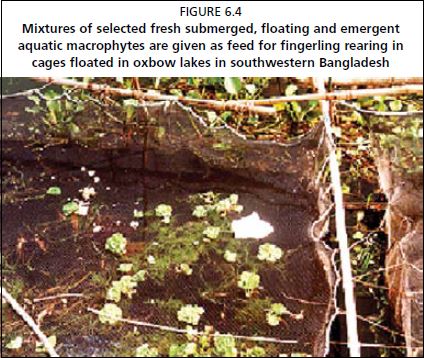
aquatic macrophytes such as Hydrilla, Najas, Ceratophyllum and duckweeds as food for grass carp.
Macrophyte preferences
Soft submerged aquatic macrophytes are readily eaten by certain herbivorous fish. The most commonly fed are hornwort, oxygen weed, water velvet, water milfoil and pondweeds. The most efficient herbivorous fish is probably the grass carp (known in the USA as the white amur). Grass carp feed voraciously on submerged aquatic macrophytes. Several investigations have been carried out to find the consumption rates and preferences of submerged aquatic macrophytes by this herbivorous fish.
Although grass carp are not specialized feeders and have been reported to consume over 170 different species of aquatic macrophytes (Redding and Midlen, 1992), they
Table 6.5
Mean stocking densities and yields of six carp species, grouped by the predominant water colour (green, brown and clear) of 14 oxbow lakes managed under Oxbow Lakes Project II

Source: modified from Bala and Hasan (1999)
were shown to have a preference for certain macrophytes over others. Cassani (1981) noted that grass carp prefer submerged, rather than floating macrophytes when they are supplied in fresh form. According to Prabhavathy and Sreenivasan (1977), grass carp are known to ignore all aquatic vegetation in the presence of oxygen weed.
Venkatesh and Shetty (1978a, 1978b) fed two submerged aquatic macrophytes (oxygen weed and hornwort) to grass carp and observed that oxygen weed was the most readily consumed, the whole plant being eaten in the process. In the case of hornwort, these authors recorded that the smaller fish preferred only the leaves, while the bigger fish fed readily on the entire plant. In another study, Bhukaswan, Pholprasith and Chatmalai (1981) reported that grass carp preferred submerged macrophytes such as water velvet and oxygen weed and floating macrophytes such as water fern. Mitzner (1978) found that grass carp of approximately 380 g have a preference for Najas and Potamogeton. The feeding preferences of the blue tilapia Tilapia aurea (weight ranging from 94-176 g) for five aquatic plants were tested by Schwartz and Maughan (1984). These authors found that the order of preference was (1) Najas guadalupensis and Chara sp.; (2) filamentous algae (predominantly Cladophora sp.); (3) Potamogeton pectinatus L.; and (4) P. nodosus.
However, the results of many studies on the preferences of grass carp and their feeding rates are not in agreement. For example, E. densa, a non-preferred macrophyte was eaten at the lowest rates in trials in the Pacific Northwest of the USA but proved to be the first choice and eaten rapidly in trials in Florida (Van Dyke. Lestie and Nall, 1984) thus contradicting other findings that this plant was only moderately preferred and consumed. Hornwort was quickly eaten in Arkansas and Colorado lakes, but not in Florida. Similarly, Bonar et al. (1990) recorded that grass carp fed on E. canadensis from three lakes at significantly different rates, but ate E. densa from two of the sites at similar rates. The latter authors further observed that the feeding rate of the grass carp was positively correlated with the concentration of calcium and lignin, but negatively correlated to the content of iron, silica and cellulose, the most important predictors for consumption rate being calcium and cellulose.
Hickling (1966), Prowse (1971) and Wiley, Pescitelli and Wike, (1986) hypothesized that feeding rate and preference in grass carp were primarily influenced by the time it took the fish to process or ‘handle’ the plant. Its fibre content or the encrustation on its surface can affect the handling time. The coarseness of macrophytes, due to the encrustation by calcium carbonate on their external surfaces, makes them unpalatable (Boyd, 1968). Because grass carp do not digest cellulose, plant cell walls must be masticated before contents can be assimilated (Hickling, 1966). Wiley, Pescitelli and Wike (1986) thought that this would increase the handling time of plants high in cellulose and should lower the preference ranking and the rate of consumption.
Pine, Anderson and Hung (1989) reported the results of a study where triploid grass carp were presented with three submerged aquatic macrophytes species (sago pondweed, Eurasian water milfoil, and longleaf pondweed) in outdoor canals with static and flowing water in winter, spring and summer. During spring and summer, grass carp showed distinct variation in their preference for aquatic weed types, depending on their environmental conditions. Plants of all three species produced longer shoots in canals with flowing water than with static water. The differences in shoot length might have altered the consumption rate and preference of the fish. Flowing conditions also had varying effects on the nutritional content of the plants, as shown in proximate analyses. The preference of triploid grass carp, however, had no correlation with the proximate analysis variables of the macrophytes. This suggests that accessibility and ease of mastication were more important in determining preference than the nutritional quality of the plants. In a further study, Pine, Anderson and Hung (1990) observed significant variations in feeding preferences and feed efficiencies of one year old grass carp for three submerged macrophytes (curlyleaf pondweed, Canadian pondweed and Eurasian water milfoil) depending on the season (winter, summer and fall) and the flow of canal water (static and flowing). These authors attributed the differences in feeding preferences partly to the accessibility of plants to the fish (owing to the difference in plant stature); plants in static canals did not grow as long as those in flowing canals.
Aquatic macrophyte preferences of grass carp have also been found to be affected by the ambient temperature. Redding and Midlen (1992) reported that grass carp consumed more of the softer and more succulent submerged aquatic macrophytes, such as Elodea, Hydrilla, Myriophyllum and Potamogeton, when water temperatures were below 12-15 ?C.
The discrepancies in the results of the various studies reviewed above suggest that ranking plant palatability on the basis of species type alone would be an over simplification. Environmental factors and fish size may also play important roles in determining the macrophyte preferences and consumption rates of grass carp.
Other herbivorous fish are known to consume submerged aquatic macrophytes, such as tilapia (Tilapia zillii and T. rendalli), Java barb (Barbonymus gonionotus) and giant gourami (Osphronemus gorami). It has also been reported that the silver barb (Puntius gonionotus) controlled dense vegetation of Ceratophyllum and Najas from a 284 ha reservoir in East Java, Indonesia within 8 months of stocking (Schuster, 1952 cited by Edwards, 1980). This author also noted that T. zillii and T. rendalli are voracious feeders of submerged macrophytes. T. zillii feeds on various types but shows preferences when feeding choices are offered. For example, Buddington (1979) reported that T. zillii preferred Najas guadalupensis as a food source to Lemna, Myriophyllum spicatum and Potamogeton pectinatus. Saeed and Ziebell (1986) conducted an experimental study by feeding different macrophytes (Chara sp., Najas marina, Elodea densa and Myriophyllum exalbescens) to T. zillii and observed that the most preferred macrophyte was Chara followed by N. marina. E. densa and M. exalbescens. These authors noted that the coarseness of these macrophytes appeared to have some influence on its consumption by the fish. N. marina has characteristically sharp-toothed leaf margins. Fish avoided the terminal bushy twigs on which the leaves are crowded while taking stems and lower leaves, probably because the spines are less numerous. Similarly, T. zillii avoided the bulky stems of E. densa and fed on the leaves and soft slender stems, which are easy to grasp and separate. Like grass carp, T. zillii also showed a diet shift with increase in size. T. zillii over 9.0 cm long were able to eat macrophytes better than their juveniles. O. gorami is another fish that feeds mainly on plant leaves and was introduced into irrigation wells in India from Java to control submerged macrophytes (Edwards, 1980).
Consumption levels
Ad libitum feeding of fresh macrophytes is generally used for herbivorous fish, although fresh weight feeding rates of 100-150 percent of body weight (BW)/day are occasionally recommended for grass carp. These empirical feeding rates have probably been derived from field observations of the consumption rates of different macrophytes by grass carp, as reviewed below. The consumption rates of oxygen weed and hornwort for grass carp were reported to be 100-150 percent BW/day (Singh et al., 1967; Bhatia, 1970). Opuszynski (1972) reported that the consumption rates for smaller sized grass carp were as high as 100-200 percent BW/day. Based on their field observations and calculations, Shireman and Maceina (1981) suggested four empirical consumption rates of grass carp for oxygen weed. These were: 100 percent BW/day for grass carp up to 3 kg; 75 percent BW/day for 3-4 kg; 50 percent BW/day for 4-6 kg; and 25 percent BW/day for >6 kg. Venkatesh and Shetty (1978a, 1978b) used fresh weight feeding rates of 100 percent and 125 percent BW/day for oxygen weed and hornwort respectively, in a growth trial with grass carp. These authors observed that the these restricted feeding rates might not have been adequate and recommended ad libitum feeding for grass carp Bhukaswan, Pholprasith and Chatmalai (1981) reported that grass carp (<1.0 kg) consume water velvet at levels as high as 243 percent and oxygen weed as high as 191 percent BW/day. In contrast, Hajra (1987) reported much lower consumption rates of hornwort by grass carp. The mean daily dry matter intake per 100 g body weight was 0.837 g and 0.977 g in small (14.4 g) and large (52.2 g) fingerlings, respectively. The fresh weight consumption approximated 25 percent of body weight.
Saeed and Ziebell (1986) recorded distinct variation in consumption while feeding four different submerged macrophytes ad libitum to T. zillii. The consumption rates were 79 percent, 67 percent, 24 percent and 16 percent BW/day for Chara sp., N. marina, E. densa and M. exalbescens respectively.
Food conversion rates
Food conversion values of diets containing varying inclusion levels of dried hornwort meal in pelleted diets fed to Nile tilapia were presented in Table 6.4. The FCR values varied between 3.7 and 4.1. All these studies were carried out for Nile tilapia only and the information for other species was not available. The FCR values were very similar even though the studies were carried out in different rearing systems, e.g. cages, earthen ponds and fibre glass tanks. However, considering the highly variable growth responses of Nile tilapia fed hornwort meal, it may not be appropriate to use these FCR values without further verification.
Food conversion ratios for fresh hornwort and oxygen weed fed to grass carp are given in Table 6.6. On a fresh weight basis, the FCR of hornwort varied between 96 and 128, while for oxygen weed it varied between 46 and 132. The apparent variation in FCR values is not surprising, considering the fact that the feeding trials were conducted in different experimental systems and under varying environmental conditions, using fish of different sizes. Devaraj, Maniserry and Keshavappa (1985) reported a fresh weight FCR of 46 for oxygen weed using 3.0 g grass carp in a cement cistern, while Keshavanath and Basavaraju (1980) obtained an FCR value of 132 for oxygen weed in an irrigation canal with 500 g grass carp. Therefore, it is difficult to generalize an FCR value from the available data. Nevertheless, for practical use, the assumption of FCRs of 100-125 for hornwort and 60-100 for oxygen weed on a fresh weight basis may be acceptable.
Digestibility
Digestibility coefficients of hornwort, oxygen weed, E. canadensis, Najas spp. and Ruppia maritima fed to fish and shrimp (Penaeus monodon) are presented in Table
Table 6.6
Food conversion ratios of hornwort and oxygen weed fed to grass carp and Nile tilapia
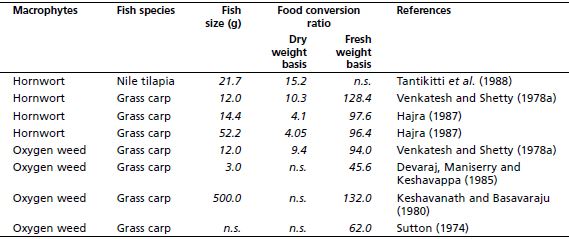
Table 6.7
Digestibility of five submerged aquatic macrophytes

1 DM = dry matter; CP = crude protein; EE = ether extract; CF = crude fibre; NFE = nitrogen free extract; G E = gross energy
6.7. Digestibility coefficients varied between both macrophyte and fish species.
Dry matter digestibility appears to be in the range of 40-70 percent, although a rather low value (29 percent) is reported for N. guadalupensis when fed to Tilapia zillii. Apparent protein digestibility (APD) varied between 64-83 percent with the exception of the 51 percent APD for hornwort reported by Venkatesh and Shetty (1978b) for grass carp.
Crude lipid digestibility coefficients varied between 67 and 83 percent (Table 6.7) with the exception of the 43 percent lipid digestibility of oxygen weed reported for rohu. The digestibility of NFE of hornwort for grass carp was 49-51 percent and that of oxygen weed for rohu was 50 percent. Data on the crude fibre digestibility of hornwort and oxygen weed was available only for grass carp and varied from 37 to 43 percent.
The wide variability in the digestive efficiency of different macrophytes can partly be attributed to the variation in experimental procedures and techniques employed in the studies reviewed. In addition, variation in chemical composition and the physical characteristics of the plants influences digestibility (Buddington, 1979). Nevertheless, for practical purposes, the dry matter, protein, lipid and carbohydrate digestibility may be taken as 40-60 percent, 60-80 percent, 70-80 percent and 50 percent respectively for these common submerged macrophytes.